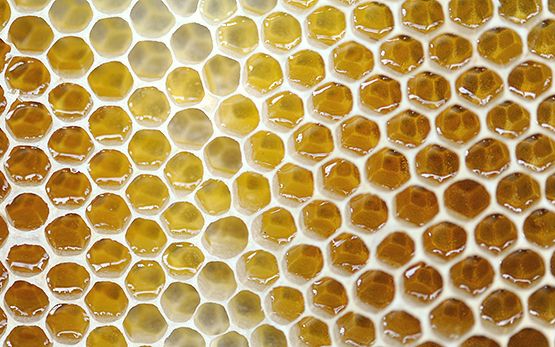Der Wassergehalt des von den Pflanzen produzierten Nektars kann variieren. Um seine Konservierung in den Waben zu gewährleisten, darf er nicht gären. Deshalb wird er von den Bienen in Honig umgewandelt, indem sie seinen Wassergehalt senken und folglich den Zuckergehalt erhöhen. Dies verhindert die Entwicklung der Mikroorganismen. In der Dunkelheit des Bienenstocks ist es schwierig, den Herstellungsprozess des Honigs zu beobachten. Aus diesem Grund ist er auch nur wenig erforscht. Um die Umwandlung von Nektar in Honig zu untersuchen, haben wir die Technik der Tomographie eingesetzt. Sie ermöglicht es, den Zuckergehalt des eingelagerten Nektars sehr präzise zu messen, ohne den Bienenstock öffnen zu müssen und das Bienenvolk zu stören.

Publications Emmanuelle Marie Arias
Louviot F., Zufferey M., Arias E. M., Weisskopf L., Eugster E.
Exploring the potential of lactic acid bacteria and carrot isolates as postharvest disease control agents in carrots.
Journal of Agriculture and Food Research, 22, 2025, Article 102053.
Shani N., Zago M., Berthoud-dit-Gallon Marchand H., Marzohl D., Michellod E., Gindro K., Giraffa G., Arias E. M.
Clostridium caseinilyticum sp. nov., a close relative of Clostridium tepidum and Clostridium sporogenes, isolated from spoiled cheese and silage.
International Journal of Systematic and Evolutionary Microbiology, 75, (8), 2025, Article 006875.
Bisig W., Arias E. M., Fröhlich M. T., Guggisberg D., Jakob E., Sheehan J. J. D., Skeie S.
Salt in cheese: Physical, chemical, biological, and sensory aspects - water activity.
Dans: Cheese: Chemistry, Physics and Microbiology. Fifth Edition, Ed. Academic Press, Amsterdam (NL). 2025, 349-406.
Roetschi A., Baumeyer Brahier A., Berthoud-dit-Gallon Marchand H., Braillard L., Gschwend F., Guisolan A., Haldemann J., Hummerjohann J., Joller C., Loosli F., Meola M., Naskova J., Oberhänsli S., Shani N., von Ah U. et autres
Antilisterial properties of selected strains from the autochthonous microbiota of a Swiss artisan soft smear cheese.
Foods, 13, (21), 2024, Article 3473.
Arias E. M., Haldemann J., Sartori C., Fehér N.
Microbiote à la surface des fromages.
Dans: 13. Swiss Cheese Awards. 4 octobre, Ed. Fromarte / Swiss Cheese Marketing, Lugano. 2024.
autres langues:
Haldemann J., Sartori C., Arias E. M., Fehér N.
Culture sur petit-lait.
Dans: 13. Swiss Cheese Awards. 9 octobre, Ed. Fromarte / Swiss Cheese Marketing, Lugano. 2024.
autres langues:
Haldemann J., Sartori C., Arias E. M., Fehér N.
Cultures mixtes brutes.
Dans: 13. Swiss Cheese Awards. 4 octobre, Ed. Fromarte / Swiss Cheese Marketing, Lugano. 2024.
autres langues:
Purtschert G., Roetschi A., Irmler S., Von Ah U., Arias E.
Lactic acid bacteria as protective cultures for plant-based food.
Dans: 28th International ICFMH Conference FOOD MICRO 2024. 8 July, Burgos. 2024, 1.
Purtschert G., Arias E.
Small consortia of microorganisms enhancing the taste and safety of our food.
Dans: 11. Nachhaltigkeitstagung. 25. January, Reckenholz. 2024, 1-18.
Roetschi A., Gschwend F., Arias E.
Leuconostoc spp. in the rind of soft smear cheese: A contribution to food safety.
Dans: 14th International Symposium on Lactic Acid Bacteria. 29 August, Ed. Royal Netherlands Society for Microbiology, Egmond aan Zee (NL). 2023, 1.
Schmidt R., Somerville V., Berthoud-dit-Gallon Marchand H., Guggenbühl B., Gschwend F., Arias E.
The sensory and microbial diversity of Bernese Alp Cheese.
Dans: 13th FACEnetwork Meeting. 11. October, Grangeneuve (CH). 2023.
Von Ah U., Arias E.
Biopreservation oder die vergessene Rolle der Fermentation.
Agrarforschung Schweiz, 14, 2023, 16-23.
Arias E.
Cheese smear or the ancestral cultivation of a beneficial biofilm.
Dans: IAFP’s European Symposium. 6 May, Ed. International Association for Food Protection, München. 2022, 1-12.
Ryser L., Arias E., Berthoud H., Delbès-Paus C., Chassard C., Bruggmann R., Irmler S.
Cadaverine, putrescine, and histamine formation of Morganella morganii in raclette-type cheese.
International Dairy Journal, 129, 2022, 1-8.
Arias E., Haldemann J.
L' effet anti-clostridia de Lactobacillus Helveticus.
Dans: Journée des conseillers en fromagerie Romands et Tessinois. 02 juillet. 2021, 1-11.
Ryser L., Arias E., Perreten V., Irmler S., Bruggmann R.
Genetic and phenotypic diversity of Morganella morganii isolated from cheese: Morganella morganii cheese isolates.
Frontiers in Microbiology, online, (17 November), 2021, 1-11.
Wechsler D., Fehér N., Haldemann J., Meola M., Guggisberg D., Fuchsmann P., Guggenbühl B., Dreier M., Shani N., Badertscher R., Egger C., Portmann R., Arias E., Schmidt R.
Caractérisation du Raclette du Valais AOP.
Agroscope Science, 115, 2021.
autres langues:
Bourdichon F., Arias E., Babuchowski A., Bückle A., Dal Bello F., Dubois A., Fontana A., Fritz D., Kemperman R., Laulund S., Mac Auliffe O., Miks M. H. , Papademas P., Patrone V., Sharma D. K. et autres
The forgotten role of food cultures.
FEMS Microbiology Letters, 368, (14), 2021, Article fnab085.
Shani N., Oberhaensli S., Arias E.
Antibiotic susceptibility profiles of Pediococcus pentosaceus from various origins and their implications for the safety assessment of strains with food-technology applications.
Journal of Food Protection, 84, (7), 2021, 1160-1168.
Burtscher J., Küller F., Dreier M., Arias E., Drissner D., Domig K. J.
Characterization of clostridium tyrobutyricum xtrains using three different typing techniques.
Microorganisms, 8, (7), 2020, 1-17.





